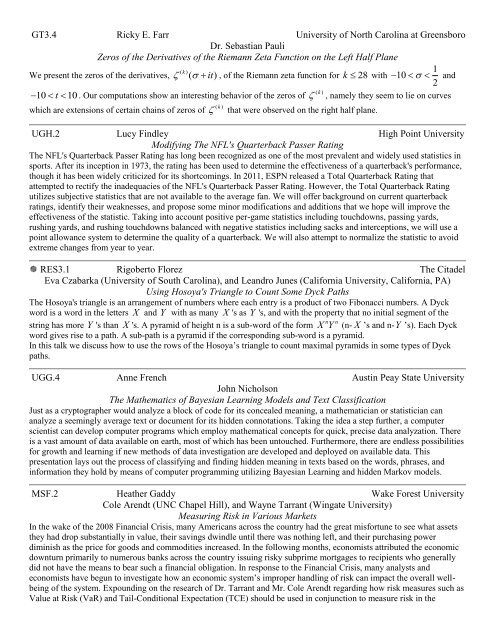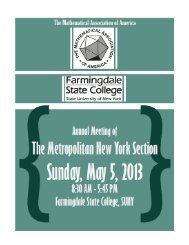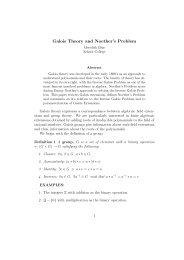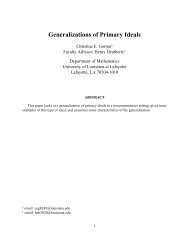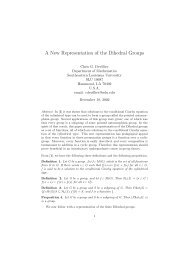Presentation Abstracts - MAA Sections
Presentation Abstracts - MAA Sections
Presentation Abstracts - MAA Sections
Create successful ePaper yourself
Turn your PDF publications into a flip-book with our unique Google optimized e-Paper software.
GT3.4 Ricky E. Farr University of North Carolina at Greensboro<br />
Dr. Sebastian Pauli<br />
Zeros of the Derivatives of the Riemann Zeta Function on the Left Half Plane<br />
( 1<br />
We present the zeros of the derivatives, k ) ( it)<br />
, of the Riemann zeta function for k 28 with 10<br />
and<br />
2<br />
10 t 10 . Our computations show an interesting behavior of the zeros of<br />
( k )<br />
which are extensions of certain chains of zeros of that were observed on the right half plane.<br />
( k )<br />
<br />
, namely they seem to lie on curves<br />
UGH.2 Lucy Findley High Point University<br />
Modifying The NFL's Quarterback Passer Rating<br />
The NFL's Quarterback Passer Rating has long been recognized as one of the most prevalent and widely used statistics in<br />
sports. After its inception in 1973, the rating has been used to determine the effectiveness of a quarterback's performance,<br />
though it has been widely criticized for its shortcomings. In 2011, ESPN released a Total Quarterback Rating that<br />
attempted to rectify the inadequacies of the NFL's Quarterback Passer Rating. However, the Total Quarterback Rating<br />
utilizes subjective statistics that are not available to the average fan. We will offer background on current quarterback<br />
ratings, identify their weaknesses, and propose some minor modifications and additions that we hope will improve the<br />
effectiveness of the statistic. Taking into account positive per-game statistics including touchdowns, passing yards,<br />
rushing yards, and rushing touchdowns balanced with negative statistics including sacks and interceptions, we will use a<br />
point allowance system to determine the quality of a quarterback. We will also attempt to normalize the statistic to avoid<br />
extreme changes from year to year.<br />
RES3.1 Rigoberto Florez The Citadel<br />
Eva Czabarka (University of South Carolina), and Leandro Junes (California University, California, PA)<br />
Using Hosoya's Triangle to Count Some Dyck Paths<br />
The Hosoya's triangle is an arrangement of numbers where each entry is a product of two Fibonacci numbers. A Dyck<br />
word is a word in the letters X and Y with as many X 's as Y 's, and with the property that no initial segment of the<br />
n n<br />
string has more Y 's than X 's. A pyramid of height n is a sub-word of the form XY (n- X ’s and n-Y ’s). Each Dyck<br />
word gives rise to a path. A sub-path is a pyramid if the corresponding sub-word is a pyramid.<br />
In this talk we discuss how to use the rows of the Hosoya’s triangle to count maximal pyramids in some types of Dyck<br />
paths.<br />
UGG.4 Anne French Austin Peay State University<br />
John Nicholson<br />
The Mathematics of Bayesian Learning Models and Text Classification<br />
Just as a cryptographer would analyze a block of code for its concealed meaning, a mathematician or statistician can<br />
analyze a seemingly average text or document for its hidden connotations. Taking the idea a step further, a computer<br />
scientist can develop computer programs which employ mathematical concepts for quick, precise data analyzation. There<br />
is a vast amount of data available on earth, most of which has been untouched. Furthermore, there are endless possibilities<br />
for growth and learning if new methods of data investigation are developed and deployed on available data. This<br />
presentation lays out the process of classifying and finding hidden meaning in texts based on the words, phrases, and<br />
information they hold by means of computer programming utilizing Bayesian Learning and hidden Markov models.<br />
MSF.2 Heather Gaddy Wake Forest University<br />
Cole Arendt (UNC Chapel Hill), and Wayne Tarrant (Wingate University)<br />
Measuring Risk in Various Markets<br />
In the wake of the 2008 Financial Crisis, many Americans across the country had the great misfortune to see what assets<br />
they had drop substantially in value, their savings dwindle until there was nothing left, and their purchasing power<br />
diminish as the price for goods and commodities increased. In the following months, economists attributed the economic<br />
downturn primarily to numerous banks across the country issuing risky subprime mortgages to recipients who generally<br />
did not have the means to bear such a financial obligation. In response to the Financial Crisis, many analysts and<br />
economists have begun to investigate how an economic system’s improper handling of risk can impact the overall wellbeing<br />
of the system. Expounding on the research of Dr. Tarrant and Mr. Cole Arendt regarding how risk measures such as<br />
Value at Risk (VaR) and Tail-Conditional Expectation (TCE) should be used in conjunction to measure risk in the


